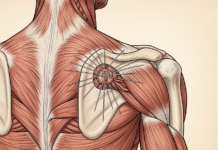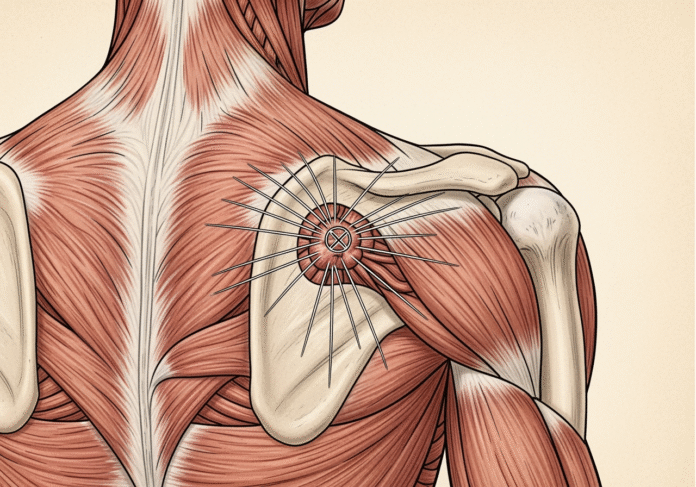Understanding the Knot in Your Shoulder Blade
Have you ever felt a small, hard lump deep within your muscle tissue, particularly around your shoulder blade? This is commonly known as a muscle knot, or more precisely, a myofascial trigger point. These aren’t just minor aches; they are hyperirritable spots within a taut band of skeletal muscle that can cause significant pain and discomfort, both locally and in referred areas.
At a microscopic level, a muscle knot represents a segment of muscle fibers that are stuck in a contracted state. Our muscles are made up of tiny filaments called actin and myosin. During contraction, myosin heads attach to actin filaments. For the muscle to relax, energy (ATP) is required to detach these heads. In a trigger point, impaired microcirculation within the muscle leads to a reduced oxygen supply. Without sufficient oxygen, the muscle cannot produce enough ATP, trapping the actin and myosin filaments in a persistent contraction. This creates a vicious cycle: sustained contraction restricts blood flow further, exacerbating the energy crisis and preventing relaxation.
The muscles most commonly affected by knots in the shoulder blade region include:
- Rhomboids: Located between the spine and the inner border of the shoulder blade, these muscles help pull the shoulder blades together.
- Trapezius: A large, diamond-shaped muscle covering the upper back and neck, often a primary site for tension and knots.
- Levator Scapulae: Running from the neck to the top of the shoulder blade, this muscle lifts the scapula and can cause pain along the neck and shoulder.
- Infraspinatus: One of the rotator cuff muscles on the back of the shoulder blade, knots here can refer pain down the arm.
Symptoms of a shoulder blade knot can range from a dull, persistent ache to a sharp, intense pain that worsens with movement or pressure. You might feel a palpable lump or a tight band of muscle. Beyond localized pain, these knots can cause referred pain, meaning the discomfort is felt in other areas of the body. For instance, knots in the upper trapezius can trigger headaches, while those in the infraspinatus might send pain radiating down the arm. This can significantly impact your daily life, making simple tasks like reaching, lifting, or even sleeping comfortably a challenge.
Understanding this physiological process helps us appreciate why these knots can be so stubborn and why specific strategies are needed for their relief.

Common Causes: Why Do Shoulder Blade Knots Form?
Muscle knots in the shoulder blade area rarely appear without reason. They are often the body’s response to chronic stress, poor habits, or injury. Identifying the underlying causes is crucial for effective relief and long-term prevention.
One of the most pervasive culprits in our modern world is poor posture. Prolonged periods spent hunched over a desk, looking down at a smartphone (often dubbed “tech neck”), or driving for long hours can place immense strain on the muscles surrounding your shoulder blades. This sustained forward-head posture and rounded shoulders force the upper back and neck muscles to work harder to support the head, leading to fatigue and the formation of trigger points. Even trying to maintain an overly rigid “military-type” posture can be detrimental, as the upper back is naturally designed to have a slight curve.

Muscle overuse and repetitive strain are also significant contributors. Activities that involve repetitive arm movements, such as painting, gardening, playing certain sports (like tennis or golf), or even carrying heavy bags or backpacks on one shoulder, can lead to muscle fatigue and micro-trauma. When muscles are constantly engaged without adequate rest or proper form, they can develop tight bands and knots. Intense upper-body workouts without proper stretching and recovery can also lead to similar issues.
Emotional stress and tension play a profound role. When we experience stress, our bodies instinctively tense up, a phenomenon known as muscle guarding. The shoulders and neck are common areas where this tension accumulates. Chronic stress can keep these muscles in a contracted state for extended periods, making them prime candidates for knot formation. This is why many people report that their shoulder knots worsen during stressful periods.
A sedentary lifestyle contributes to the problem by reducing overall muscle activity and blood circulation. Lack of movement can lead to stiffness and weakness in the muscles, making them more susceptible to developing knots. Conversely, previous injuries or muscle imbalances can also predispose you to shoulder blade knots. When one muscle group is weak or injured, other muscles compensate, becoming overworked and developing trigger points. For example, tight pectoral muscles can pull the shoulders forward, forcing the upper back muscles to overstretch and weaken, leading to knots between the shoulder blades.
Taking regular posture breaks every 30–60 minutes during long desk sessions can significantly help prevent these muscle kinks from forming.
At-Home Strategies for Immediate Relief
When a muscle knot strikes, immediate relief is often the top priority. Fortunately, several effective self-care techniques can help alleviate discomfort and encourage muscle relaxation.
Self-Massage and Pressure Application
Direct pressure on a muscle knot can help release the tight fibers and improve local blood flow. This technique, often called trigger point release, involves applying firm but tolerable pressure to the knot.
- Using a Tennis Ball or Lacrosse Ball: These tools are excellent for reaching knots in your shoulder blade area. Place the ball between your back and a wall or the floor. Lean into the ball, allowing it to press directly on the knot. Apply firm but tolerable pressure for 30–60 seconds, repeating 2–3 times a day. The sensation should be a “good hurt”—intense but not excruciating. If it hurts too much, ease off the pressure. You can also make small circular motions or roll slowly over the area.
- Foam Roller Techniques: While a ball offers more targeted pressure, a foam roller can be effective for broader areas of tension across your upper back. Lie on your back with the foam roller perpendicular to your spine, just below your shoulder blades. Cross your arms over your chest to open up your shoulder blades, and gently roll up and down, pausing on any tender spots.

Therapeutic Heat and Cold Therapy
Alternating between hot and cold treatments can be highly effective in managing muscle knot pain.
- Heat Therapy: Heat helps relax tight muscles by increasing blood flow to the affected area. This increased circulation brings oxygen and nutrients, aiding the muscle’s natural healing process. Apply a heating pad, warm compress, or hot water bottle to the knot for 15–20 minutes. A warm bath or shower, directing the stream onto your upper back, can also provide soothing relief.
- Cold Therapy: Cold helps to reduce inflammation and numb the painful area. Use a cold compress for about 10 minutes, then remove it for at least 15 minutes before reapplying.
- Alternating Therapy: Some find alternating between hot and cold therapy most beneficial, as it combines the muscle-relaxing effects of heat with the anti-inflammatory benefits of cold. Experiment to see which works best for you.
Essential Stretches and Mobility Exercises
Gentle stretching can significantly help release tension and improve flexibility around your shoulder blades. Incorporate these into your daily routine:
- Doorway Pectoral Stretch: Stand in a doorway, place your forearms on the frame with elbows bent at 90 degrees. Lean forward gently until you feel a stretch across your chest. This helps counteract rounded shoulders and tight pectoral muscles, which often contribute to shoulder blade knots. Hold for 20-30 seconds, repeating 2-4 times.
- Cat-Cow Pose: Start on your hands and knees. As you inhale, arch your back, drop your belly, and lift your head (Cow Pose). As you exhale, round your spine towards the ceiling, tuck your chin, and pull your navel towards your spine (Cat Pose). This gentle spinal movement improves mobility in the upper back.
- Child’s Pose: Kneel on the floor, sit your hips back towards your heels, and extend your arms forward, resting your forehead on the ground. This pose gently stretches the back and shoulders, releasing tension between the shoulder blades.
- Shoulder Blade Squeeze: Sit or stand tall with relaxed shoulders. Gently squeeze your shoulder blades together as if trying to hold a pencil between them. Hold for 5-10 seconds, then release. Repeat 8-12 times. This strengthens the muscles that support your shoulder blades and improves posture.

A Proactive Approach to Personalized Body Pain Relief
While immediate relief strategies are crucial, a proactive approach focusing on prevention and long-term management is key to truly untangling those stubborn shoulder blade knots. This involves integrating ergonomic adjustments, strengthening exercises, and healthy lifestyle choices into your daily routine.
The Role of Posture and Ergonomics for Personalized Body Pain Relief
Good posture is your first line of defense against muscle knots. Our modern lifestyles, dominated by screens and sedentary work, often lead to poor postural habits that strain the upper back and shoulders.
- Correcting Forward Head Posture: Ensure your ears are aligned over your shoulders, and your shoulders are relaxed, not hunched or rounded.
- Monitor Height: Position your computer monitor so the top of the screen is at eye level. This prevents you from craning your neck downwards.
- Chair Adjustments: Use an ergonomic chair that supports the natural curve of your spine. Ensure your feet are flat on the floor and your knees are at a 90-degree angle. Your elbows should also be bent at 90 degrees when typing, with your wrists straight.
- Taking Movement Breaks: Even with perfect ergonomics, prolonged static positions are detrimental. Take posture breaks every 30–60 minutes during long desk sessions. Stand up, walk around, and perform a few gentle stretches. Setting a timer can be a helpful reminder. Regular movement helps maintain blood flow and prevents muscle tension from building up.

Strengthening and Prevention Exercises
Addressing muscle imbalances and strengthening the supporting muscles around your shoulder blades can significantly reduce the likelihood of knots forming.
- Strengthening Upper Back Muscles: Focus on exercises that engage the rhomboids and middle trapezius, which pull your shoulder blades back and down. Examples include:
- Rows: Whether with dumbbells, resistance bands, or a rowing machine, focus on squeezing your shoulder blades together at the end of the movement.
- Face Pulls: Using a cable machine or resistance band, pull the rope towards your face, externally rotating your shoulders. This targets the rear deltoids and rotator cuff muscles.
- Scapular Pushups: In a plank position, keeping your arms straight, depress and protract your shoulder blades, then retract them, allowing your chest to drop slightly without bending your elbows.
- Rotator Cuff Strengthening: These smaller muscles are crucial for shoulder stability. Incorporate exercises like external rotations with light weights or resistance bands.
Lifestyle Adjustments for Lasting Comfort
Beyond physical adjustments, broader lifestyle choices play a critical role in muscle health and pain management.
- Stress Management: As we’ve discussed, stress directly contributes to muscle tension. Incorporate stress-reducing activities into your routine, such as deep breathing exercises, meditation, yoga, or spending time in nature.
- Proper Hydration: Dehydration can contribute to muscle cramps and stiffness. Ensure you’re drinking plenty of water throughout the day.
- Nutrients for Muscle Health: A balanced diet rich in essential minerals like calcium, potassium, and magnesium supports healthy muscle function and can help prevent knots.
- Importance of Adequate Sleep: Quality sleep allows your muscles to repair and recover. Ensure you’re getting 7-9 hours of restful sleep each night.
By combining these proactive strategies, you can create an environment that supports healthy muscle function and significantly reduces the occurrence of shoulder blade knots, leading to lasting comfort and improved well-being.
When to Seek Professional Help for Shoulder Blade Knots
While many muscle knots can be effectively managed with self-care, there are instances when professional intervention becomes necessary. It’s crucial to recognize the limitations of at-home remedies and understand when to consult a healthcare provider. Most muscle kinks resolve in a few days to a week with proper care, but chronic knots may take longer and often indicate a deeper issue.
You should seek professional help if:
- Persistent or Severe Pain: If your muscle knot pain lasts longer than 1-2 weeks despite consistent self-care efforts, or if the pain is severe and significantly impacts your daily activities or sleep.
- Numbness or Tingling: If you experience numbness, tingling, or weakness radiating into your arm or hand, this could indicate nerve involvement, which requires professional evaluation.
- Weakness in the Arm or Hand: Any noticeable loss of strength in your affected arm or hand should prompt a visit to a doctor.
- Pain Interfering with Sleep: If the pain from the knot consistently disrupts your sleep, it’s a sign that it’s more than a minor issue.
- Red Flag Symptoms: If the shoulder blade pain is accompanied by difficulty breathing, chest tightness, fever, or sudden severe pain, seek immediate medical attention as these could indicate a more serious underlying condition.
Exploring Professional Treatment Options for Personalized Body Pain Relief
When self-care isn’t enough, various healthcare professionals can offer targeted treatments:
- Physical Therapy: A physical therapist can conduct a thorough assessment to identify the root cause of your knots, including muscle imbalances, postural issues, or movement dysfunctions. They can then design a personalized exercise program, provide manual therapy techniques (such as myofascial release and trigger point massage), and offer ergonomic advice. Physical therapy often focuses on strengthening weak muscles and stretching tight ones to restore balance.
- Deep Tissue Massage: A trained massage therapist can apply specific techniques to release chronic muscle tension and improve circulation in the affected area. Deep tissue massage can be particularly effective for breaking down stubborn knots.
- Chiropractic Adjustments: If the knots are related to spinal misalignment or joint dysfunction in the upper back or neck, a chiropractor can perform adjustments to restore proper joint movement and reduce muscle tension.
- Dry Needling: Performed by trained practitioners (often physical therapists or chiropractors), dry needling involves inserting thin needles into trigger points to elicit a “twitch response,” which can help the muscle relax and reduce pain.
- Injections: In some cases, a doctor might recommend trigger point injections, which involve injecting a local anesthetic, sometimes with a corticosteroid, directly into the knot to alleviate pain and inflammation.
A comprehensive approach to Personalized body pain relief often involves a combination of these professional techniques custom to your specific condition. Consulting with a healthcare provider will help determine the most appropriate course of action for your unique situation.
Frequently Asked Questions about Shoulder Blade Knots
We often encounter common questions about muscle knots in the shoulder blade. Here are some answers to help clarify any lingering concerns:
How long does it take for a muscle knot to go away?
The duration for a muscle knot to resolve varies depending on its severity, cause, and the consistency of treatment. Acute knots, often resulting from a new strain or temporary poor posture, may resolve in a few days to a week with diligent self-care, including rest, heat, and gentle stretching. However, chronic knots, which have been present for a longer time or are due to ingrained postural habits or significant muscle imbalances, can take much longer to resolve. These often require more persistent effort and may benefit significantly from professional intervention like physical therapy or deep tissue massage to address the underlying causes.
Is it okay to massage a painful muscle knot?
Yes, it is generally okay and often beneficial to massage a painful muscle knot. Applying firm but tolerable pressure on a knot for 30–60 seconds, repeated 2–3 times a day, can help increase blood flow, break up adhesions, and encourage the muscle fibers to relax. The key is to ensure the pressure is tolerable—it should feel like a “good hurt” or a release, not sharp or excruciating pain. If the pain is too intense, you might be pressing too hard or on the wrong spot. Avoid over-massaging the area, as this can lead to further irritation. Using tools like a tennis ball, a lacrosse ball, or even a massage cane can help you apply consistent pressure without fatiguing your hands.
Can a muscle knot be a sign of something more serious?
While muscle knots are typically benign and a common musculoskeletal complaint, in some cases, persistent or unusual symptoms accompanying a knot could indicate a more serious underlying condition. If a muscle knot is accompanied by symptoms such as radiating numbness, tingling, or weakness in your arm or hand, this could suggest nerve compression or irritation. If you experience sudden, severe pain, difficulty breathing, or chest tightness along with shoulder blade pain, seek immediate medical attention as these could be signs of a medical emergency. Additionally, if the lump feels unusually hard, fixed, or grows in size, or if you have a fever or unexplained weight loss, it’s crucial to have it evaluated by a healthcare professional to rule out other conditions, such as a swollen lymph node, a cyst, or other more serious medical issues. Always err on the side of caution and consult a doctor if you have any concerns about your symptoms.
Conclusion
Muscle knots in the shoulder blade are a common and often debilitating issue, but they are far from untreatable. By understanding what these knots are, why they form, and how to effectively address them, you can take significant steps toward a pain-free life.
We’ve explored how factors like poor posture, overuse, stress, and muscle imbalances contribute to these stubborn knots. We’ve also provided a comprehensive toolkit of at-home strategies, from self-massage and therapeutic temperature application to essential stretches and mobility exercises. Beyond immediate relief, we emphasized the importance of a proactive approach, integrating ergonomic adjustments, strengthening exercises, and healthy lifestyle choices for long-term prevention.
While self-care is powerful, knowing when to seek professional help is equally vital. Persistent pain, radiating symptoms, or any concerns about your discomfort warrant a consultation with a healthcare provider. Combining immediate self-care with long-term prevention and professional guidance when needed empowers you to effectively manage and eliminate shoulder blade knots. Listen to your body, be consistent with your efforts, and take proactive steps toward achieving lasting comfort and well-being.























